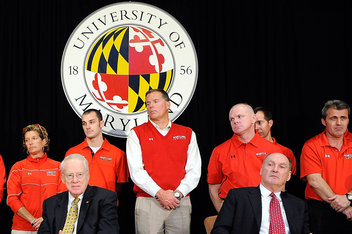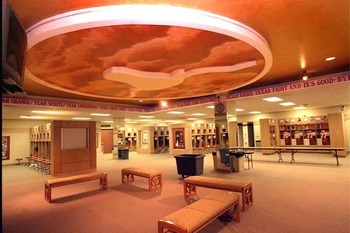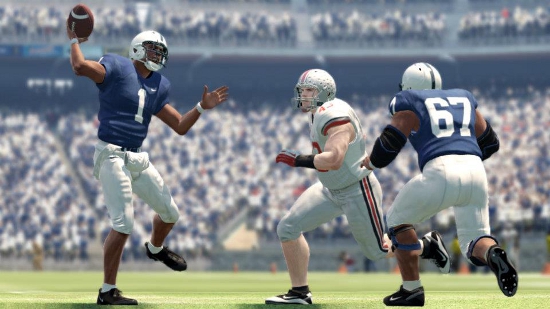
As I write this, players wearing maize and blue and scarlet and grey are stretching and warming up inside Ohio Stadium. Unsurprisingly, this means I am quite nervous and keyed up since The Game is only fifty minutes from kickoff. The annual contest between Michigan and Ohio State goes back over a century and has filled the intervening decades with jaw-dropping plays, gut-check defensive stands, and thrilling wins (or embittering defeats) for both sides. Bound up in this end of the year game is a wealth of feelings: regional animus, cultural identity, and the simple matter of bragging rights that mean something. It’s everything that is right and good about college football.
I am not here to write about everything that is right and good about college football, though. Instead, what I want to talk about is the business of college football. Earlier this week the Big Ten Conference announced two new additions to its membership starting in 2014: the University of Maryland will leave the ACC and Rutgers University will leave the Big East to become the 13th and 14th members of the alliance still known as the Big Ten (I’m not even going to touch that particular bit of…math). These moves are only the latest in a 3-year long cycle of schools moving from conference to conference in a dizzying cycle of realignment.
In December 2009 the Big Ten released a short statement that said they were exploring adding a new school to the league for the 1st time since Penn State joined in the early 90’s (the last addition to the Big Ten was Michigan State 40 years prior). In the tumult since then, the entire landscape of collegiate sports has been rewritten. Six months later the Big Ten filched Nebraska from the Big 12 and all hell broke loose. The Pac-10 grabbed Colorado from the Big 12 and elevated Utah from the Mountain West to become the Pac-12. The University of Texas threatened to join the Pac-12 as well, holding the rest of its home conference the Big 12 hostage in the process and nearly causing its collapse. A year later the story would repeat itself and UT’s historic rival Texas A&M defected to the Southeastern Conference in disgust, taking the University of Missouri with it. The Big 12 picked itself up off the mat by adding overachieving Texas Christian University and the geographical oddity of West Virginia University (WVU’s closest neighbor in the Big 12 is more than 800 miles away from Morgantown; when they were in the Big East they were a mere 78 miles away from conference-mate the University of Pittsburgh). Around the same time the Big East, always the weakest of the major football conferences lost charter members Syracuse University and the aforementioned Pitt to the ACC. To replace those teams lost to the Big 12 and ACC (which was raiding the Big East for the 2nd time in the past decade, Virginia Tech, Miami, and Boston College jumped over in 2004), the Big East elevated more schools from the minor leagues (such college sports luminaries as Central Florida, Memphis, Southern Methodist, and Houston) and just plain reached for schools that were successful but literally a continent away (Boise State and San Diego State). Earlier this year, Notre Dame (always an independent in football) moved all of its other sports from the Big East to the ACC and started a football scheduling agreement with the latter league. Which in turn leads us back to the Big Ten adding Maryland and Rutgers (and the ACC grabbing Louisville from the Big East to replace Maryland this past week).
Got all that? Probably not. It’s a mess. Here’s a Wikipedia article that outlines all of it in much clearer form. The reason for all this shifting is, of course, money.

Since the NCAA lifted restrictions on TV broadcasts and subsequent broadcast rights (after being sued by the conferences) in the early 80’s there has been a deluge of money into collegiate sports. With each new contract from the broadcast networks and ESPN the richest conferences and their most powerful member schools became flush with unprecedented amounts of cash. By the time the Big Ten’s eponymous cable network had found its bearing in 2009 each member school was getting a $24 million paycheck from the TV broadcasts of football games each year. This incredible influx of money has created two major problems for me as a college football fan.
First, that money is not flowing down to the young men earning it. College football players receive grant-in-aid scholarships, of course, but in most cases that is not enough to cover the complete cost of college attendance. Further, the NCAA’s ridiculous and outdated amateur rules prevent these players from being directly compensated for their efforts (not even the kind of living expense stipends that other grant-in-aid recipients are allowed) and they are not allowed to earn a profit off of their own likenesses or exploits. This means that players are not allowed to accept endorsements or sell autographs or jerseys, because those rights are reserved for their schools and the NCAA. The most egregious example of this is the NCAA Football games from EA Sports, which allows gamers (like myself) simulate an endless amount of games as our favorite teams and players. But, the game ships with “anonymous” players and no names on jerseys, so as to skirt the ban on profiting off of amateurs’ likenesses. Now, any idiot will know that the 6’1″ quarterback for Michigan who runs like the wind is Denard Robinson, but according to the NCAA that is just an invented player named QB#16 who has no attributes based on any real-life person. This sort of laughable mendaciousness could be forgiven if it wasn’t patently exploitative and detrimental to the athlete’s future prospects. Witness the horrific injury sustained by South Carolina’s Marcus Lattimore back in October. The former All-American was having a comeback season after suffering an ACL tear last season when his cleat stuck in the turf while he was tackled. The subsequent knee dislocation and compound fracture means that Lattimore may never walk correctly again, much less profit from his exceptional skills as a running back in the NFL. The fact that he may never be compensated for the endless hours of training, practice, and performance that he put in seems downright criminal to me.

Secondly, because all of this money cannot flow down to the people that earn it, huge pools of money are left to the coaches and executives on top of the pyramid to spend on salaries and facilities. There’s nothing people with enormous amounts of money want more than even more money, which is why we have seen the surge of expansionism. Maryland and Rutgers joining the Big Ten is perhaps the best example of this, as neither schools has the geographical proximity, competitive history, or financial commitment to athletics of their new conference-mates. So their addition was not an effort on the part of the Big Ten to create better games or a more competitive conference, as one would ideally want. Instead, they provide big new markets and content streams for the Big Ten Network. If the conference can get their network onto the basic packages of the cable carriers in New York City and Washington, D.C.(two cities that have little history of caring about college sports) the windfall will be enormous for the coaches, athletic directors, and conference executives who will receive that money. Such naked money-grubbing is behind all these moves of course, but when it becomes a bigger factor than the regional animosity, unvarnished on-field competition, or sense of history that defines the best of college football the whole sport is devalued. I’m not looking forward to seeing Michigan play games in College Park or Piscataway because the Wolverines have no history in those stadiums and will only be there in order to bilk unknowing cable customers out of a few extra dollars on their cable bill. Maybe I’m just a revanchist on this matter, but the future of my favorite game feels threatened because the people in charge have lost sight of anything but the almighty dollar. Beating Ohio State (which will have to wait til next year…grumble grumble Al Borges) does not make me as a fan or the players on the field richer in anything but spirit. If only the same was true of the those whose decisions will dictate where, when, and how those future games are played.





